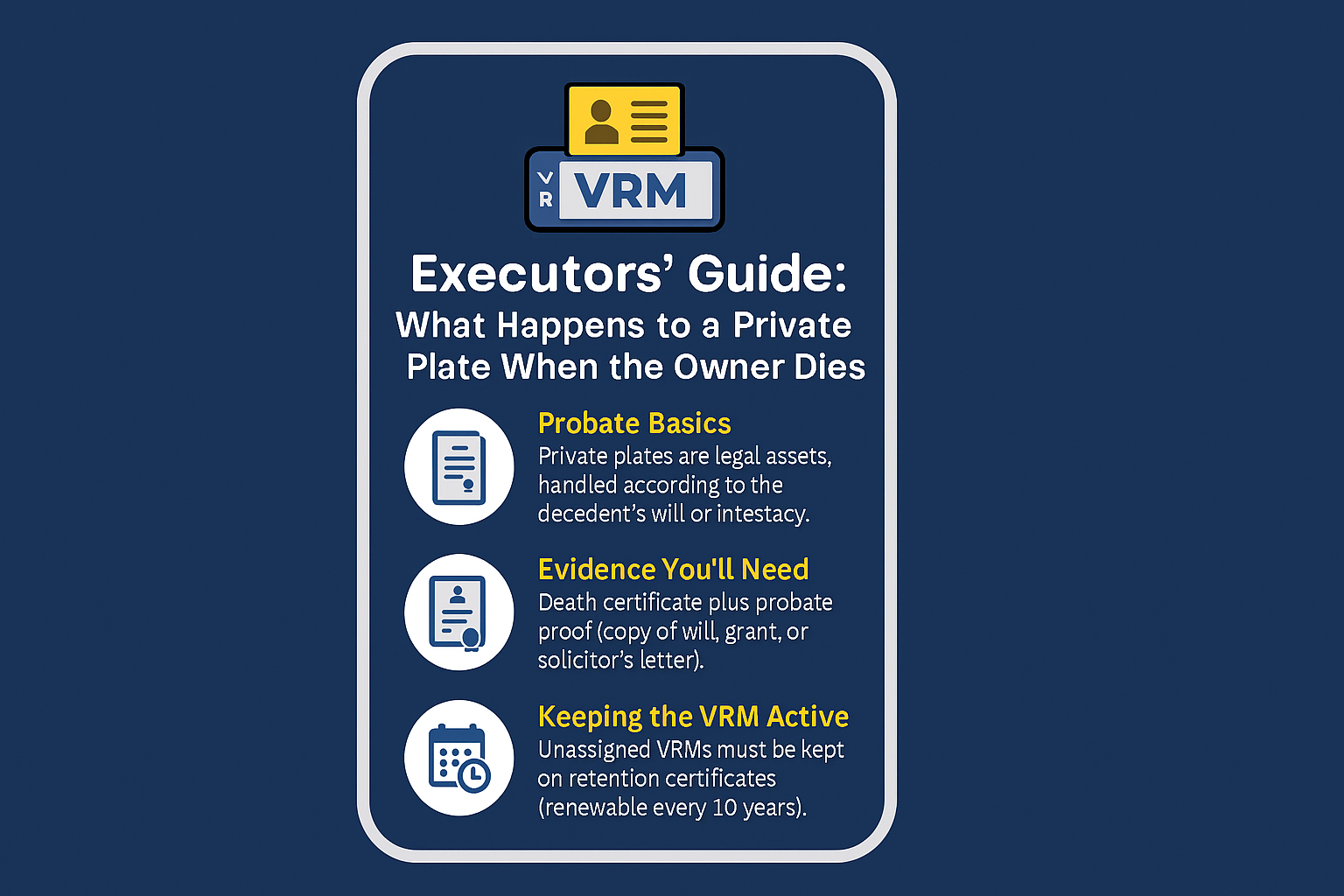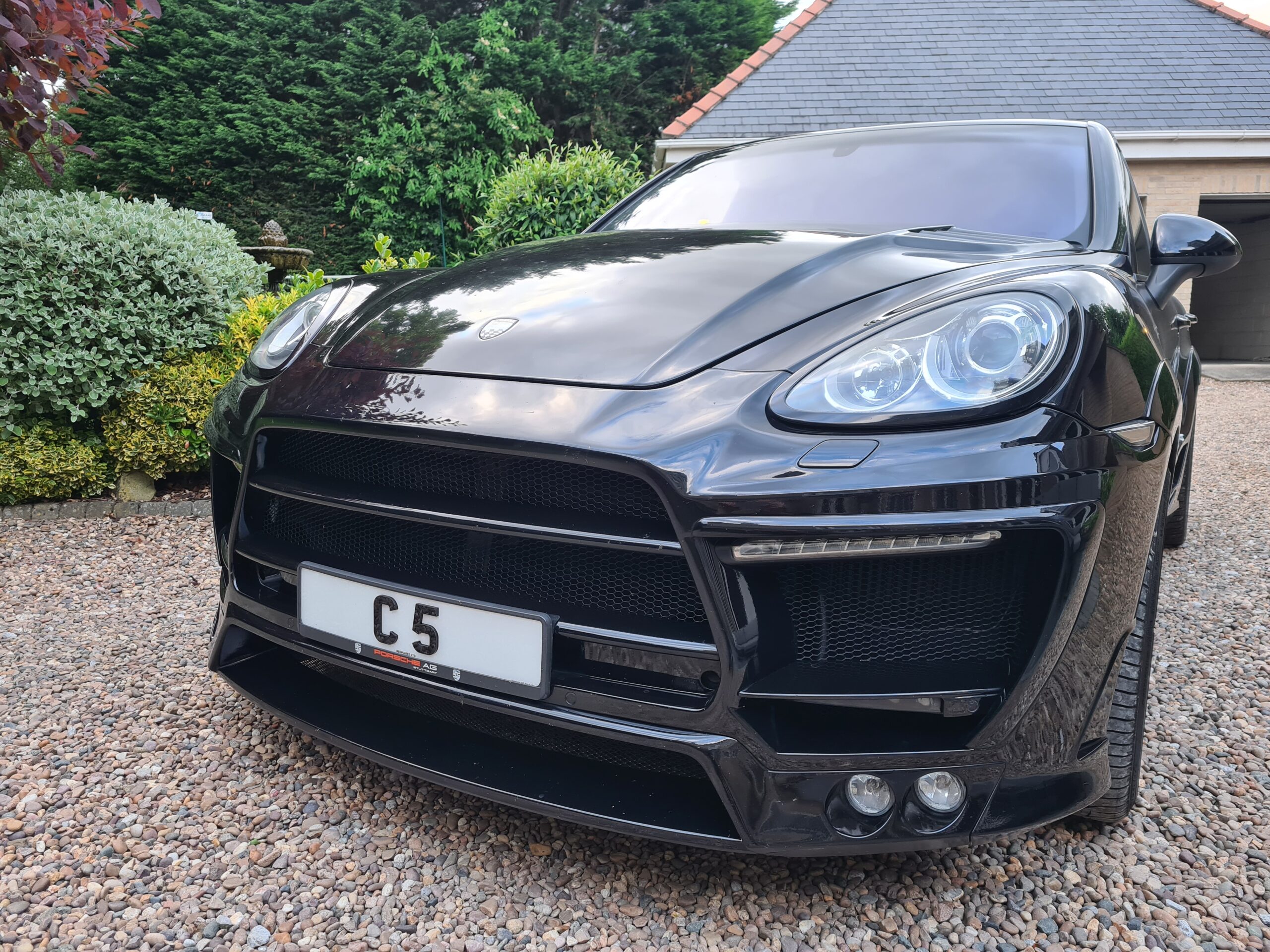
Probate basics, evidence you’ll need, and how to keep the VRM active
When a private number plate owner passes away, their cherished registration becomes part of their estate. Whether the plate is assigned to a vehicle or held on a retention certificate, it’s the executor’s responsibility to manage it correctly. This guide explains what happens to a private plate after death, what evidence is required, and how to keep the VRM (Vehicle Registration Mark) active — ensuring it isn’t lost or misused.
Probate and the Executor’s Role
Probate is the legal process of administering a deceased person’s estate. If the deceased left a will, the named executors are responsible for distributing assets, including any private number plates. If there’s no will, administrators are appointed under intestacy rules.
Private plates are considered intellectual property assets and can be retained, transferred, or relinquished. Executors must decide whether to:
- Keep the plate for themselves or a beneficiary
- Transfer it to another person
- Assign it to a different vehicle
- Allow it to lapse
What Evidence Do You Need?
To act on a private plate after the owner dies, the DVLA requires proof that you have the legal authority to manage the registration. You’ll need:
- Death certificate (original or certified copy)
- Proof of probate — one of the following:
- A certified copy of the grant of probate
- A copy of the will
- A solicitor’s letter confirming the executor or next of kin
You must also include a covering letter signed by all executors, stating your intentions for the plate — whether retaining, transferring, or releasing it.
For full guidance, refer to the DVLA’s official page on personalised registrations.
If the Plate Is Assigned to a Vehicle
If the private plate is currently on a vehicle, you’ll need to complete a V317 form to transfer or retain the registration. The process depends on the type of logbook (V5C):
- New style V5C (multi-coloured blocks): fill in section 2
- Older style V5C: fill in section 6
Include the following:
- Death certificate
- Probate evidence
- V317 form
- Covering letter signed by all executors
- £80 transfer or retention fee
Send everything to: DVLA Personalised Registrations, Swansea SA99 1DS
If the plate is to be transferred to a new vehicle or person, include their details in the covering letter.
If the Plate Is Held on Retention (V778 or V750)
If the plate is not assigned to a vehicle but held on a retention certificate (V778) or certificate of entitlement (V750), the process is slightly different:
- Executors must sign the V778 or V750
- Include the death certificate and probate evidence
- Add a covering letter signed by all executors stating your intentions
Send the documents to: DVLA Cherished Transfers Team, Swansea SA99 1BW
If the certificate is missing, you can still apply by sending the death certificate, probate evidence, and a covering letter explaining the situation.
For more on retention certificates, see our guide: 👉 How to Retain a Private Number Plate
Transferring the Plate to a New Owner
If the plate is to be transferred to a beneficiary or sold, the new owner must meet DVLA’s eligibility criteria. The executor must:
- Ensure all documents are signed and submitted
- Include the new owner’s details in the covering letter
- Confirm all executors agree to the transfer
Once DVLA approves the transfer, the new owner will receive updated documentation confirming their right to use the plate.
Keeping the VRM Active
To keep a private plate active, it must either be:
- Assigned to a vehicle
- Held on a valid retention certificate (V778)
Retention certificates are valid for 10 years and must be renewed before expiry. DVLA allows renewal online or by post up to 28 days before the certificate expires.
If the certificate expires and is not renewed, the right to use the plate is lost — and the VRM may become available for public purchase. Executors should act promptly to avoid losing valuable or sentimental registrations.
For tips on preserving plate value, read: 👉 How to Value a Private Number Plate
Can You Get a Refund?
If the deceased paid the £80 assignment fee but never assigned the plate to a vehicle, a refund may be possible. To qualify:
- The plate must not have been assigned
- You must hold a valid V778 or V750
- If the document is lost, DVLA may issue a replacement
Check the certificate to confirm if a fee was paid and contact DVLA for refund eligibility.
What Happens If You Do Nothing?
If no action is taken, the plate may:
- Remain assigned to the deceased’s vehicle
- Expire if held on retention
- Be lost if the certificate lapses
In some cases, the plate may be transferred with the vehicle if sold — meaning the buyer acquires the right to use it. Executors should ensure the plate is removed or retained before selling the vehicle.
Tips for Executors
- Act early: Don’t wait until the retention certificate expires or the vehicle is sold.
- Communicate with co-executors: DVLA requires all executors to sign the covering letter.
- Keep copies: Retain copies of all documents sent to DVLA.
- Check expiry dates: V778 and V750 certificates have a 10-year validity.
- Use recorded delivery: When sending documents to DVLA, use a tracked postal service.
DVLA Contact Details
- Assigned plates: DVLA Personalised Registrations Swansea SA99 1DS
- Unassigned plates (retention): DVLA Cherished Transfers Team Swansea SA99 1BW
Summary Checklist
| Task | Required Documents | DVLA Form | Fee |
| Transfer plate from vehicle | Death certificate, probate proof, covering letter | V317 | £80 |
| Retain plate on certificate | Death certificate, probate proof, covering letter | V778 or V750 | £80 |
| Transfer plate to new owner | Same as above + new owner details | V317 or V750 | £80 |
| Refund request | Valid V778/V750, proof of payment | Covering letter | None |
Private plates often carry emotional and financial significance. Executors have a duty to manage these assets responsibly, ensuring they’re retained, transferred, or relinquished according to the deceased’s wishes and DVLA rules. With the right documents and timely action, you can preserve the VRM and honour its legacy.
If you’re an executor handling a private plate, Regplates.com is here to help. Whether you need advice, valuation, or assistance with transfers, our team offers expert support to guide you through every step.

Jon Cherry is a Director of leading personalised number plate dealer Regplates.com. Jon has over 25 years industry experience handling some of the most expensive plates ever sold with many high profile and celebrity clients. Active since 1991 in the number plate industry, Jon is currently Chairman of the Cherished Numbers Guild, a trade body representing number plate dealers in the UK. Jon has written many articles on the industry and insight into the future of numberplates and the market as a whole.




